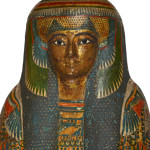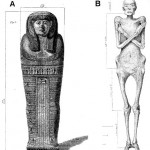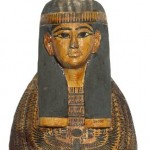
A visit to the British Museum’s exhibition “Ancient Lives. New Discoveries”
By Andrea Byrnes. Published in Egyptological, Magazine Reviews. 16th June 2014 Ancient Lives. New Discoveries British Museum Exhibition dates: 22nd May – 30th November 2014 Sponsored by Julius Baer; Technology Partner – Samsung When I arrived home after visiting and enjoying Ancient Lives, I found that a friend who has also visited the […] [more…]

The Significance of the Crossed Arms Pose – Part 2: Osiris, The Osiris and the Osirides
Is it a futile activity to ask, as I do in this series of articles, “What is The Significance of the Crossed-Arm Pose?” It might be argued, for instance, that variations in the pose at death exhibited by royal mummies simply reflect what embalmers decided to do on the day, or at least the customary practice of a particular undertaker. Similarly, it might be argued that each individual anthropoid coffin might be expected to reveal some unique design characteristic, and that no significance should be attached to the specific hand/arm pose depicted on the lid. [more…]

The Significance of the Crossed Arms Pose in the New Kingdom – Part 1
Amongst the many miracles through which delicate objects are preserved from ancient Egypt down into modern times, perhaps the most remarkable is the survival of the mortal remains of a virtually complete sequence of New Kingdom rulers. These kings, along with a number of queens and lesser royalty – who date from the end of the Seventeenth Dynasty through to the start of the Twenty-Second Dynasty – are generally referred to as the Royal Mummies, and were for the most part recovered from the Royal Cache of 1881 (in tomb TT320), and the Second Royal Cache of 1898 (in tomb KV35, the tomb of Amenhotep II). [more…]
Edition - July, 2012

21st Dynasty Mummification
By Michelle HY Low. Published on Egyptological, In Brief, 24th July 2012. The death of Ramesses XI marked the end of the 20th Dynasty and the New Kingdom, which consequently led to the emergence of the 21st Dynasty and the Third Intermediate Period. With the emergence of this new era, Egypt experienced an instability not […] [more…]

The Egyptian Collection of the Archaeological Museum of Zagreb and its Mummies
The Egyptian collection in the Archaeological museum in Zagreb currently has over 2,300 artifacts of Ancient Egypt, and is the largest and most complete collection of its kind in Croatia. The first acquisition, the Zagreb mummy, is still its most famous artifact today. It came to the museum in 1862, and remains the core of the collection. Another part of the collection was bought from a famous Roman junkman in Naples called Lancia (Tomorad 2003). Studies revealed that most items came from Luxor and the surrounding areas. [more…]
 By
By 